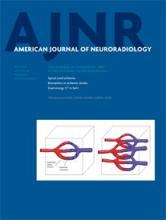Research ArticleBrain
Open Access
Increased Number of White Matter Lesions in Patients with Familial Cerebral Cavernous Malformations
M.J. Golden, L.A. Morrison, H. Kim and B.L. Hart
American Journal of Neuroradiology May 2015, 36 (5) 899-903; DOI: https://doi.org/10.3174/ajnr.A4200
M.J. Golden
aFrom the Departments of Radiology (M.J.G., B.L.H.)
L.A. Morrison
bNeurology (L.A.M.), University of New Mexico, Albuquerque, New Mexico
H. Kim
cDepartments of Anesthesiology and Perioperative Care (H.K.)
dEpidemiology and Biostatistics (H.K.), University of California, San Francisco, San Francisco, California.
B.L. Hart
aFrom the Departments of Radiology (M.J.G., B.L.H.)

REFERENCES
- 1.↵
- 2.↵
- Kattapong VJ,
- Hart BL,
- Davis LE
- 3.↵
- Gunel M,
- Awad IA,
- Finberg K, et al
- 4.↵
- Zabramski JM,
- Wascher TM,
- Spetzler RF, et al
- 5.↵
- Akers AL,
- Ball KL,
- Clancy M, et al
- 6.↵
- Christiansen P,
- Larsson HB,
- Thomsen C, et al
- 7.↵
- Vernooij MW,
- Ikram MA,
- Tanghe HL, et al
- 8.↵
- Osborn AG
- 9.↵
- Liao D,
- Cooper L,
- Cai J, et al
- 10.↵
- Hopkins RO,
- Beck CJ,
- Burnett DL, et al
- 11.↵
- Katzman GL,
- Dagher AP,
- Patronas NJ
- 12.↵
- 13.↵
- 14.↵
- Wieshmann UC
- 15.↵
- Stockton RA,
- Shenkar R,
- Awad IA, et al
- 16.↵
- Glading A,
- Han J,
- Stockton RA, et al
- 17.↵
- 18.↵
- Tu J,
- Stoodley MA,
- Morgan MK, et al
- 19.↵
- Clatterbuck RE,
- Eberhart CG,
- Crain BJ, et al
- 20.↵
- Hart BL,
- Taheri S,
- Rosenberg GA, et al
- 21.↵
- Young VG,
- Halliday GM,
- Kril JJ
In this issue
American Journal of Neuroradiology
Vol. 36, Issue 5
1 May 2015
Advertisement
M.J. Golden, L.A. Morrison, H. Kim, B.L. Hart
Increased Number of White Matter Lesions in Patients with Familial Cerebral Cavernous Malformations
American Journal of Neuroradiology May 2015, 36 (5) 899-903; DOI: 10.3174/ajnr.A4200
0 Responses
Jump to section
Related Articles
- No related articles found.
Cited By...
This article has been cited by the following articles in journals that are participating in Crossref Cited-by Linking.
- Miguel Alejandro Lopez-Ramirez, Gregory Fonseca, Hussein A. Zeineddine, Romuald Girard, Thomas Moore, Angela Pham, Ying Cao, Robert Shenkar, Bart-Jan de Kreuk, Frederic Lagarrigue, Jack Lawler, Christopher K. Glass, Issam A. Awad, Mark H. GinsbergJournal of Experimental Medicine 2017 214 11
- Abdul G Mikati, Omaditya Khanna, Lingjiao Zhang, Romuald Girard, Robert Shenkar, Xiaodong Guo, Akash Shah, Henrik BW Larsson, Huan Tan, Luying Li, Matthew S Wishnoff, Changbin Shi, Gregory A Christoforidis, Issam A AwadJournal of Cerebral Blood Flow & Metabolism 2015 35 10
- Hélène Choquet, Eliana Trapani, Luca Goitre, Lorenza Trabalzini, Amy Akers, Marco Fontanella, Blaine L. Hart, Leslie A. Morrison, Ludmila Pawlikowska, Helen Kim, Saverio Francesco RettaFree Radical Biology and Medicine 2016 92
- Courtney C. Hong, Alan T. Tang, Matthew R. Detter, Jaesung P. Choi, Rui Wang, Xi Yang, Andrea A. Guerrero, Carl F. Wittig, Nicholas Hobson, Romuald Girard, Rhonda Lightle, Thomas Moore, Robert Shenkar, Sean P. Polster, Lauren M. Goddard, Aileen A. Ren, N. Adrian Leu, Stephanie Sterling, Jisheng Yang, Li Li, Mei Chen, Patricia Mericko-Ishizuka, Lukas E. Dow, Hideto Watanabe, Markus Schwaninger, Wang Min, Douglas A. Marchuk, Xiangjian Zheng, Issam A. Awad, Mark L. KahnJournal of Experimental Medicine 2020 217 10
- Janne Koskimäki, Sean P. Polster, Yan Li, Sharbel Romanos, Abhinav Srinath, Dongdong Zhang, Julián Carrión-Penagos, Rhonda Lightle, Thomas Moore, Seán B. Lyne, Agnieszka Stadnik, Kristina Piedad, Ying Cao, Robert Shenkar, Alexey V. Dimov, Nick Hobson, Gregory A. Christoforidis, Timothy Carroll, Romuald Girard, Issam A. AwadGeroScience 2020 42 5
- Abdul K. Parchur, Zhi Fang, Jaidip M. Jagtap, Gayatri Sharma, Christopher Hansen, Shayan Shafiee, Wenquan Hu, Qing R. Miao, Amit JoshiBiomaterials Science 2020 8 18
- Luca Massimi, Souvik Kar, Mario Giordano, Helmut Bertalanffy2019
- Satoshi Tsutsumi, Ikuko Ogino, Masakazu Miyajima, Hajime Arai, Masanori Ito, Yukimasa YasumotoJournal of the Neurological Sciences 2016 367
- KD Flemming, Jonathan Graff Radford, Ross Reichard, James Klaas, Sherri Braksick, Petrice Cogswell, Giuseppe LanzinoActa Neurochirurgica 2024 166 1
More in this TOC Section
Similar Articles
Advertisement











